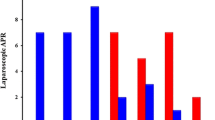Abstract
Background
In abdominoperineal resection (APR) in male patients with rectal cancer, high margin involvement and urethral injury have been reported to result from difficulty in dissecting the anterior anorectum. Recently, the efficacy of an endoscopic down-to-up rectal dissection was reported. Here, we present a safe and simple technique for anterior dissection using a simultaneous laparoscopic and transperineal endoscopic approach.
Methods
We perform transperineal APR (TpAPR) using both the laparoscopic and transperineal approach (a 2-team approach). Anterior dissection commences just behind the superficial transverse perineal muscle. Next, the striated muscle complex surrounding the rectum (levator ani and puborectalis muscle) is divided. At this point, it is difficult to identify the dissection plane between the membranous urethra and anterior rectum; thus, dissection along the lateral aspect of neurovascular bundle from the lateral to anterior side with the assistance of the laparoscopic team is helpful in identifying the posterior surface of the prostate. Once the prostate is identified, it is relatively easy to divide the rectourethralis muscles. The key steps of our procedure are shown in the video.
Results
Between April 2016 and July 2019, we performed 14 TpAPR procedures in male patients with rectal cancer without distant metastasis. Extended surgery was performed in 8 patients, including pelvic sidewall dissection and combined resection of adjacent organs. Median operative time was 453 min and median blood loss was 46 g. There was 1 (7.1%) circumferential-positive case, but no cases of urethral injury or rectal perforation.
Conclusions
The 2-team TpAPR procedure is beneficial for appropriate dissection of the anterior side during APR surgery.
Similar content being viewed by others
References
Penna M, Hompes R, Arnold S, Wynn G, Austin R, Warusavitarne J et al (2018) Incidence and risk factors for anastomotic failure in 1594 patients treated by transanal total mesorectal excision: results from the international TaTME registry. Ann Surg 269(4):700–711
Fleshman J, Branda M, Sargent DJ, Boller AM, George V, Abbas M et al (2015) Effect of laparoscopic-assisted resection vs open resection of stage II or III rectal cancer on pathologic outcomes: the ACOSOG Z6051 randomized clinical trial. JAMA 314(13):1346–1355
Holm T (2014) Controversies in abdominoperineal excision. Surg Oncol Clin N Am 23(1):93–111
Simillis C, Baird DL, Kontovounisios C, Pawa N, Brown G, Rasheed S et al (2017) A systematic review to assess resection margin status after abdominoperineal excision and pelvic exenteration for rectal cancer. Ann Surg 265(2):291–299
Hasegawa S, Okada T, Hida K, Kawada K, Sakai Y (2016) Transperineal minimally invasive approach for extralevator abdominoperineal excision. Surg Endosc 30(10):4620–4621
Hasegawa S, Takahashi R, Hida K, Kawada K, Sakai Y (2016) Transanal total mesorectal excision for rectal cancer. Surg Today 46(6):641–653
Sylla P, Knol JJ, D'Andrea AP, Perez RO, Atallah SB, Penna M et al (2019) Urethral injury and other urologic injuries during transanal total mesorectal excision: an international collaborative study. Ann Surg. https://doi.org/10.1097/SLA.0000000000003597
Atallah S, Mabardy A, Volpato AP, Chin T, Sneider J, Monson JRT (2017) Surgery beyond the visible light spectrum: theoretical and applied methods for localization of the male urethra during transanal total mesorectal excision. Tech Coloproctol 21(6):413–424
Atallah S, Vela I (2019) How to avoid urethral injury in males. Transanal minimally invasive surgery (TAMIS) and transanal total mesorectal excision (taTME). Springer, Dordrecht, pp 321–333
Uchimoto K, Murakami G, Kinugasa Y, Arakawa T, Matsubara A, Nakajima Y (2007) Rectourethralis muscle and pitfalls of anterior perineal dissection in abdominoperineal resection and intersphincteric resection for rectal cancer. Anat Sci Int 82(1):8–15
Muro S, Tsukada Y, Harada M, Ito M, Akita K (2018) Spatial distribution of smooth muscle tissue in the male pelvic floor with special reference to the lateral extent of the rectourethralis muscle: application to prostatectomy and proctectomy. Clin Anat (New York, NY) 31(8):1167–1176
den Dulk M, Putter H, Collette L, Marijnen CA, Folkesson J, Bosset JF et al (2009) The abdominoperineal resection itself is associated with an adverse outcome: the European experience based on a pooled analysis of five European randomised clinical trials on rectal cancer. Eur J Cancer (Oxford, England, 1990) 45(7):1175–1183
Sylla P, Rattner DW, Delgado S, Lacy AM (2010) NOTES transanal rectal cancer resection using transanal endoscopic microsurgery and laparoscopic assistance. Surg Endosc 24(5):1205–1210
Atallah S, Martin-Perez B, Albert M, deBeche-Adams T, Nassif G, Hunter L et al (2014) Transanal minimally invasive surgery for total mesorectal excision (TAMIS-TME): results and experience with the first 20 patients undergoing curative-intent rectal cancer surgery at a single institution. Tech Coloproctol 18(5):473–480
Kojima D, Hasegawa S, Komono A, Sakamoto R, Matsumoto Y, Takeshita I et al (2019) Transperineal abdominoperineal resection synchronously assisted by laparoscopic approach for low rectal cancer directly invading the posterior wall of the vagina. Tech Coloproctol 23(1):65–66
Stelzner S, Holm T, Moran BJ, Heald RJ, Witzigmann H, Zorenkov D et al (2011) Deep pelvic anatomy revisited for a description of crucial steps in extralevator abdominoperineal excision for rectal cancer. Dis Colon Rectum 54(8):947–957
Lee L, de Lacy B, Gomez Ruiz M, Liberman AS, Albert MR, Monson JRT et al (2019) A multicenter matched comparison of transanal and robotic total mesorectal excision for mid and low-rectal adenocarcinoma. Ann Surg 270(6):1110–1116
Author information
Authors and Affiliations
Corresponding author
Ethics declarations
Disclosures
The authors Suguru Hasegawa, Ryuji Kajitani, Taro Munechika, Yoshiko Matsumoto, Hideki Nagano, Hirotaka Taketomi, Akira Komono, Naoya Aisu, Gumpei Yoshimatsu, Mitsuaki Morimoto, and Yoichiro Yoshida have no conflicts of interest or financial ties to disclose.
Additional information
Publisher's Note
Springer Nature remains neutral with regard to jurisdictional claims in published maps and institutional affiliations.
Electronic supplementary material
Below is the link to the electronic supplementary material.
Supplementary video (MP4 405,864 kb)
Rights and permissions
About this article
Cite this article
Hasegawa, S., Kajitani, R., Munechika, T. et al. Avoiding urethral and rectal injury during transperineal abdominoperineal resection in male patients with anorectal cancer. Surg Endosc 34, 4679–4682 (2020). https://doi.org/10.1007/s00464-020-07655-9
Received:
Accepted:
Published:
Issue Date:
DOI: https://doi.org/10.1007/s00464-020-07655-9




